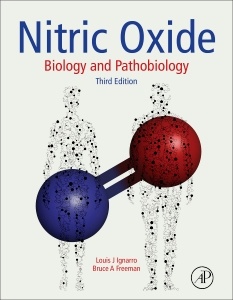Nitric Oxide (3rd Ed.) Biology and Pathobiology
Coordonnateurs : Ignarro Louis J., Freeman Bruce

Nitric Oxide: Biology and Pathobiology, Third Edition, provides information on nitric oxide, a signaling molecule of key importance for the cardiovascular system that regulates blood pressure and blood flow to different organs.
With recent links to the role of nitric oxide in the expression of healthy benefits of controlled diet and aerobic exercise, and the reactions of nitric oxide that can impact cell signaling, this book provides a comprehensive resource during a time when increased research attention is being paid across the fields of pharmacology, biochemistry, cell and molecular biology, chemistry, immunology, neurobiology, immunology, nutrition sciences, drug development and the clinical management of both acute and chronic diseases.
Perspective 1. A concise history of the discovery of mammalian nitric oxide (nitrogen monoxide) biogenesis
Chemical Biology 2. An integrated view of the chemical biology of NO, CO, H2S and O2 3. Detection of nitric oxide and related species in biological systems: A state-of-the-art review 4. S-nitrosothiols and nitric oxide biology and therapeutics 5. Cooperative interactions between NO and H2S: Chemistry, biology, physiology, pathophysiology 6. Heme protein metabolism of NO and nitrite
Enzymology 7. Cross-regulation between iNOS/NO and Wnt/ß-catenin signaling pathways 8. Regulation and physiological functions of NO-sensitive guanylyl cyclase 9. Upcoupling eNOS in cardiovascular disease
Biology/Pharmacology 10. Synthesis, actions and perspectives of nitric oxide in photosynthetic organisms 11. Mitochondria and nitric oxide 12. Nitric oxide formation from inorganic nitrate 13. Biochemistry of molybdopterin nitrate/nitrite reductases 14. NOS, NO and the red cell 15. Update on nitrite reduction in ischaemic disease: Mechanisms and clinical translation 16. Electrophilic Nitro-Fatty Acids: Nitric Oxide and Nitrite-Derived Signaling Mediators and New Drug Candidates 17. Regulation of redox signaling by a nitrated nucleotide and reactive cysteine persulfides 18. Diffusional control of nitric oxide in the vessel wall 19. Asymmetric-Dimethylarginine 20. The role of nitric oxide in epigenetic regulation
Inflammation and Pathobiology 21. Peroxynitrite formation and detection in living cells 22. Nitric oxide in sepsis and hemorrhagic shock: Beneficial or detrimental? 23. NO signaling defects in hypertension 24. Nitric oxide regulation of cardiovascular physiology and pathophysiology 25. Inhaled nitric oxide: Current clinical use and future potential uses and development 26. The defective arginine-nitric oxide pathway in sickle cell disease 27. Aberrant nitric oxide signaling contributes to protein misfolding in neurodegenerative diseases via S-nitrosylation and tyrosine nitration 28. NO in cancer: Carcinogenesis, metastases and therapy
The content of the 3rd Edition was designed to be of relevance to a broad readership, spanning from students new to the field to more experienced basic- and physician-scientists.
Bruce Freeman, PhD is the Irwin Fridovich Distinguished Professor and Chair of the Department of Pharmacology and Chemical Biology at the University of Pittsburgh School of Medicine. He has extensive experience in the biochemistry and pharmacology of nitric oxide signaling and oxidative inflammatory reactions. He and his research team have pioneered the discovery of potent inflammatory and cell signaling mediators, that are now being translated into new therapeutic strategies by Complexa, Inc.
- Includes perspectives from Jack Lancaster on the discovery of EDRF and nitric oxide
- Provides detailed coverage of the new gaseous signaling agents
- Features expanded coverage on the principles of biology, including nitric oxide synthases, nitrite and nitrate biology and pathobiology, and signaling mechanisms
- Incorporates expanded pathobiology coverage, including nitric oxide and cardiovascular function, obesity, diabetes, and erectile function/dysfunction
Date de parution : 07-2017
Ouvrage de 434 p.
21.4x27.6 cm
Mots-clés :
β-catenin; 3-nitrotyrosine; acetylation; acute respiratory distress syndrome; ADMA; aldehyde oxidase (AO); anemia; angiogenesis; angiotensin; antimicrobial; aquatic photosynthetic microorganisms; arginase; arginine; atherosclerosis; autophagy; bioenergetics; biotin switch assay; blood pressure; boronates; cancer; carbon monoxide; carcinogenesis; cardiac regeneration; cardiac surgery; cardiovascular; cardiovascular disease; cell signaling; cell-free hemoglobin; cGMP; cGMP signaling; clinical trial; cysteine persulfide; cytokines; DDAH; demethylation; diabetes; diet; diffusion; dioxygen; dioxygenation; electrophile; endothelial function; eNOS S-glutathionylation; eNOS uncoupling; epigenetics; erythrocrine function; erythrocytes; flavin adenine dinucleotide (FAD); global arginine bioavailability ratio; guanylyl cyclase; heme; heme protein; hemoglobin; hemolysis; hemorrhagic shock; histones; hydrogen peroxide; hydrogen sulfide; hydropersulfide; hypertension; hypoxia; immune deregulation; immune system; inflammation; inhalation; inhibition of platelet aggregation; iNOS; iron deficiency; ischemia; ischemia-reperfusion injury; kinetics; knockout; land plants; malaria; metals; methylation; microRNA; mitochondria; mitochondrial amidoxime reducing component (mARC); molecular chaperone; molybdopterin; myocardial contractility; myoglobin; nicotinamide adenine dinucleotide (NAD/NADH); nitrate; nitric acid; nitric oxide; nitric oxide synthase; nitrite; nitro-fatty acid; nitroalkene; nitrogen dioxide; nitroso-redox balance; nitrovasodilator; NO; nonheme iron; NOS; nucleophile; oxidation; oxidative stress



